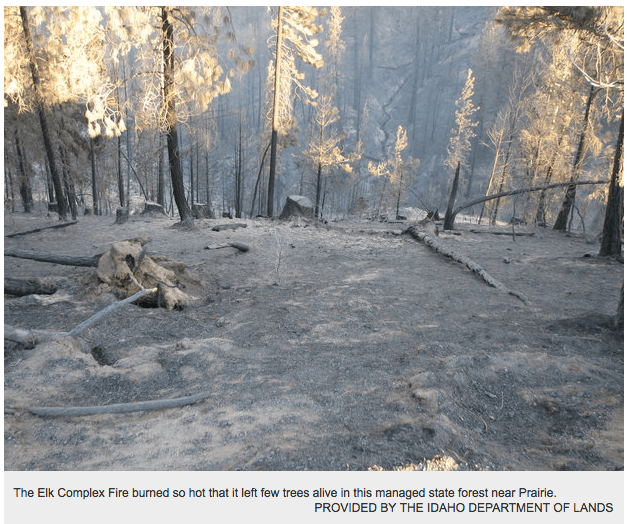
You can read Rocky Barker’s entire article here. Below are some highlights.
Emmett logger Tim Brown had just completed the White Flat timber sale on the Boise National Forest near Prairie when the Elk Complex Fire burned through in early August, destroying most of the remaining trees.
“That timber sale completely burned up,” said Dave Olson, a Boise National Forest spokesman.
The same happened on state lands nearby.
With extremely dry conditions and 50-mph winds, the fire burned so intensely that even the 6,000 acres of intensively managed state endowment forests burned, said Idaho Department of Lands Director Tom Schultz.
“There is little that land managers can do to prevent that kind of intense fire behavior,” said Schultz, who holds a master’s degree in forestry.
Matthew.. I don’t think anyone claimed that fuel treatments ALWAYS work, depending on fire conditions. They have shown that they do work, in many cases, to change fire behavior to reduce impacts and reduce impacts and provide defensible space.
If the photograph is typical of a “state managed stand,” it sure doesn’t appear to be managed for exposure to fire. Ground fuels, ladder fuels, and contiguous canopies are a recipe for wildfire, not a defense. This would be an extremely poor example of “fuel treatment,” if indeed that was what it was intended/promoted to be.
How much thinning do you need to do to have much impacts on a steep slope like that? Not much of a canopy to carry a fire but conditions might have allowed it to torch even with a canopy more sparse than even this. I don’t see that there was much fuel left on the ground after logging.
Hi greg: I’m guessing much of the understory fuel was tall grasses (easily reaching the branches of some of the visible ladder fuels), shrubs, and litter, in addition to logging debris as evidenced by the stumps and larger chucks of remaining fuel.
So far as the “how much” question is concerned, I would use historical documentation and common sense to arrive at a spacing and density pattern that could tolerate regular prescribed burns, which would have resolved much of the grasses, shrubs, debris, and lower limb problems. The area can obviously grow commercial trees, as evidenced by the snags and stumps. Based solely on this photo, I’m guessing 5 to 10 big green trees per acre, with mostly grass and forb understory — and bare ridgelines, possibly including fields of shrubs — may have survived this fire event if the land had been managed in that manner.
Nothing like 20-20 hindsight with hardly any evidence, though!
Matthew
Based on past discussions, I think that you may be missing a fine point and I hope you can see where the article validates what I have been saying since I joined this group. Since you noted the credentials of Tom Schultz let me just say that my credentials include a masters in Quantitative Forest Management from one of the top forestry schools in the country.
Isolated managed stands surrounded by poorly managed or nature only stands have a significantly poorer chance of being protected from crown fires in the adjoining lands than if those adjoining stands were also managed.
When I speak of the ability of sound forest management to reduce the probability of small fires from going catastrophic, I am speaking of a significant proportion of the acres being in the form of a matrix of managed stands of various ages and conditions. This matrix will help to break up the fire’s momentum by bringing a crown fire to the ground and will allow fire services to utilize those breaks to more easily bring the fire to an end when appropriate. This quote from the article validates what I have been trying to tell you for a long time: “the value of a forest that’s been thinned, logged or cleared by prescribed burn that brings a raging crown fire to the ground where firefighters can control it has been proved repeatedly over the past 20 years”
But even then, as I have also said many times, it is all a matter of probabilities, I agree that: ““Often, but not always, fuel treatment works,” said Penny Morgan, a fire ecology professor at the University of Idaho. “They are not 100 percent effective.””